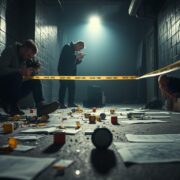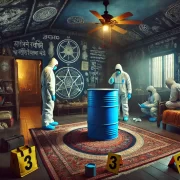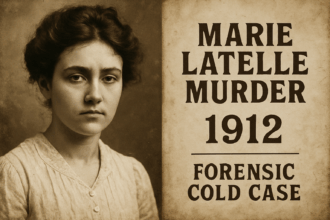The BTK killer spread terror across Wichita, Kansas. He claimed at least 10 lives between 1974 and 1991 and managed to escape capture for more than three decades. His victims included a 9-year-old child. The killer’s brazen nature showed through his taunting letters to local media, where he proudly called himself the one who would “Bind, Torture, Kill.”
The case took an unexpected turn when he broke his 13-year silence in 2004, leading to his capture. The notorious killer made a fatal error by sending a 1.44 MB floppy disk to a local TV station. This small piece of digital evidence
Let’s see how a simple floppy disk helped catch one of America’s most elusive serial killers. This case study examines how forensic analysis of digital evidence, particularly metadata, played a pivotal role in solving one of the most notorious serial killer cases in American history. It offers insights into the evolving landscape of criminal investigations.
- The Early Life of Dennis Rader: The Making of the BTK Killer
- The Reign of Terror: BTK’s Killing Spree (1974-1991)
- The first murders and BTK’s signature
- Escalation and Hiatus
- Taunting communications with police and media
- Why the case went cold for years
- The Unexpected Return: BTK Resurfaces in 2004
- Breaking the silence after 13 years
- New letters and packages to media outlets
- The escalating communication pattern
- The Cat and Mouse Game: Police Strategy to Catch BTK
- Building a psychological profile
- Using media to communicate with the killer
- The critical question about the floppy disk
- The Fatal Mistake: How BTK Killer Got Caught
- The purple floppy disk arrival
- What metadata revealed about ‘Dennis’
- Connecting the dots to Christ Lutheran Church
- From Digital Clue to Physical Arrest
- Confession and Aftermath: BTK’s Reaction to Being Caught
- Timeline of Key Events in the BTK Case
- Conclusion
The Early Life of Dennis Rader: The Making of the BTK Killer
Dennis Rader, infamously known as the BTK Killer, was born on March 9, 1945, in Pittsburg, Kansas, the eldest of four sons to William and Dorothea Rader. His family soon moved to Wichita, where Rader grew up in a modest home on N. Seneca Street. On the surface, his childhood seemed typical—raised in a religious Lutheran household, he joined the Boy Scouts, attended Riverview Elementary, and was active in church youth groups. Classmates described him as a quiet, studious, and reserved child, often withdrawn and lacking a sense of humor, preferring solitude over socializing.
However, beneath this facade, Rader harbored dark impulses from a young age. He later admitted to developing sadistic fantasies about bondage, control, and torture while in grade school, imagining tying up women to dominate them. These fantasies weren’t just sexual but rooted in a need for control. He engaged in disturbing behaviors, such as torturing small animals—hanging cats and dogs—and exhibited voyeurism, autoerotic asphyxiation, and cross-dressing, often spying on neighbors while wearing stolen women’s clothing. Forensic psychologist Dr. Tony Ruark suggests a childhood event may have linked sexual pleasure with suffering in Rader’s mind. At the same time, serial killer researcher Dr. Terence G. Leary theorizes possible exposure to “horrific abuse” within the family, though no definitive evidence exists.
Rader’s parents worked long hours—his father was at an electric utility, and his mother was often distracted—leaving him feeling ignored, which may have deepened his isolation. He graduated from Wichita Heights High School in 1963, attended Kansas Wesleyan College briefly in 1965, and then joined the U.S. Air Force in 1966, serving until 1970 in places like Korea and Greece. His military record was unremarkable, earning him medals for good conduct. Still, he later admitted to engaging with prostitutes and continuing his “trolling” behavior—stalking women without acting on his impulses.
Returning to Wichita in 1970, Rader married Paula Dietz in 1971 and worked various jobs at Coleman Co. and an IGA supermarket. He earned an associate degree in electronics from Butler County Community College in 1973 and began studies at Wichita State University, though he struggled academically. By late 1973, after losing a job at Cessna, Rader’s unemployment and disturbed mindset pushed him deeper into his fantasies. He began actively “trolling” for victims, fixating on Julie Otero and her daughter, setting the stage for his first murders in January 1974.
The Reign of Terror: BTK’s Killing Spree (1974-1991)
Dennis Rader, who dubbed himself the BTK Killer (Bind, Torture, Kill), sent numerous taunting letters and packages to the police and media over the years, detailing his crimes and mocking law enforcement’s inability to catch him. His murders began in 1974 with the brutal quadruple homicide of the Otero family and continued until 1991, claiming a total of 10 victims, including men, women, and children. After a 13-year silence following his last known murder, Rader resumed communication in 2004, seeking attention and validationValidation, often referred to as method validation, is a crucial process in the laboratory when introducing a new machine, technology, or analytical technique. It involves a series of systematic steps and assessments to ensure that Read Full Definition. This need for recognition ultimately led to his downfall, highlighting the psychological dimensions of serial killers and their interactions with law enforcement. His brutal spree mixed careful planning with sadistic pleasure and became one of America’s most disturbing serial killer cases.

The first murders and BTK’s signature
Dennis Rader began his criminal spree on January 15, 1974, with the murder of the Otero family in Wichita, Kansas. He killed Joseph, his wife Julie, and their two children, Josephine (11) and Joseph Jr. Otero (9), using his signature method of binding, torturing, and killing, which gave him his nickname.
He bound his victims with complex knots, tortured them mentally and physically, and killed them by strangulation. This brutal quadruple homicide set the tone for his subsequent crimes, targeting women and families with a mix of strangulation and stabbing.
Escalation and Hiatus
Over the years, Rader committed additional murders, including Kathryn Bright on April 4, 1974, Shirley Vian on March 17, 1977, Nancy Fox on December 8, 1977, Marine Hedge on April 27, 1985, Vicki Wegerle on September 16, 1986, and Dolores Davis on January 19, 1991. Each murder followed a similar pattern; however, unlike most serial killers, who kill more often as time goes on, Rader had long, quiet periods between his victims.
Rader often leaves notes or poems at the scenes, further taunting the police. He stole personal items from his female victims during attacks, including underwear, driver’s licenses, and other keepsakes. These “trophies” fed his sexual fantasies between killings and let him relive the murders.
After his last known victim, Davis’s murder in 1991, Rader went silent for 13 years, leading many to believe he had stopped or died.
Taunting communications with police and media
The murders weren’t the only disturbing part – Rader felt compelled to contact authorities. Rader’s communication with law enforcement started shortly after his first murders, on March 17, 1974, when he sent his first letter to The Wichita Eagle in October 1974 and claimed he killed the Oteros. Police confirmed that details in his poorly typed, misspelled letter could only come from someone at the crime scene.
Rader compared himself to other notorious killers in his messages. He said “factor X” drove him – a supernatural element he thought also pushed Jack the Ripper and the Son of Sam to kill. He wrote strange poems, like “Oh! Death to Nancy,” a twisted version of the American folk song “O Death.”
Media coverage wasn’t enough for him. He sent another letter to KAKE-TV in February 1978 asking: “How many do I have to kill before I get a name in the paper or some national attention?”. He suggested several nicknames for himself, and “The BTK Strangler” stuck. Wichita Police Chief Richard LaMunyon had to acknowledge the BTK threat after this letter publicly.
This pattern of sending letters and packages continued, providing insight into his psyche and later aiding in his capture.
Why the case went cold for years
The BTK case had unique challenges that made it hard to solve. Rader didn’t fit typical serial killer patterns. He spread his murders across 17 years with long gaps, including eight years between some victims.
He didn’t match the typical loner profile, either. He lived an everyday life as a family man, church leader, and compliance officer. His job as a compliance officer in Park City, Kansas, satisfied his need for power and control between murders. He carefully stalked potential victims and kept a list of 55 “projects” or targets but only attacked when everything lined up perfectly.
His sexual fantasies helped space out the murders. He dressed dolls in his victims’ stolen items and acted out detailed scenarios that temporarily satisfied his urges. He once said the public should be “grateful” for his fantasy life, hinting he might have killed more often without this outlet.
BTK vanished from public view after killing Dolores Davis in 1991. People thought his reign of terror had ended, and the case faded away. The investigators later learned that the monster was waiting for the right time to come back and get attention again.
The Unexpected Return: BTK Resurfaces in 2004
A serial killer who seemed to vanish without a trace shocked the Wichita community by suddenly reappearing after more than a decade. The predator who spread terror across Kansas during the 1970s and 1980s was ready to start something new. This time, his campaign focused not on murder but on getting attention, which would lead to his capture.
Breaking the silence after 13 years
On January 11, 2004, The Wichita Eagle ran a story about the 30th anniversary of the Otero family murders. This simple news piece stirred something dangerous. Dennis Rader, a 58-year-old compliance officer and church leader living a quiet life, later said the article “really stirred it.” He admitted he felt “kind of bored” because his children had grown up, and he couldn’t control his urges.
Rader claimed he had “retired” from killing, but his need for recognition never went away. He felt particularly annoyed that a local lawyer planned to write a book about the BTK case. He explained later, “Eventually, I was going to tell the story on my terms, not his terms… They didn’t know how I worked and moved around the projects, the haunts, how I picked my victims”.
The silence broke on March 19, 2004, when the Wichita Eagle received a letter signed “Bill Thomas Killman” (BTK). The package contained startling evidence: photocopies of Vicki Wegerle’s driver’s license and disturbing photos of her body that had never been made public.
New letters and packages to media outlets
Eagle reporter Hurst Laviana knew right away these materials were significant. The photos weren’t from the crime scene — EMTs had moved Wegerle’s body before police arrived, so no official images existed. The killer must have taken these pictures himself.
A flood of messages followed throughout 2004. On May 5, KAKE-TV received a letter with a fake ID, suggested chapter titles for a BTK biography, and a word-search puzzle called “Chapter 8.” Sharp observers later spotted the letters R-A-D-E-R clustered around 6220, his home address.
Someone found Communication No. 3 stuck to a stop sign in June at First and Kansas. The message included an outline of 13 chapters titled “The BTK Story.” Chapter 1 simply read: “A serial killer is born”.
The escalating communication pattern
The messages became stranger and more frequent as time passed. Library staff found a package on July 17 where BTK claimed responsibility for killing 19-year-old Jake Allen. Allen had died, but BTK had nothing to do with his death.
Communication No. 5 appeared in a UPS box at Second and Kansas on October 22. It seemed to be an autobiography that mixed “many details that turned out to be deceptions, with bits of truth interspersed.” A Murdock Park walker discovered a December package containing Nancy Fox’s driver’s license and a Barbie doll. The doll’s head was hooded, and its arms were tied behind its back.
Police believe Rader still wanted to kill despite these communications. He kept “prowling, planning to kill again” through 2004 and had picked out a possible victim through his Animal Control job.
The messages intensified by early 2005. On February 3, BTK sent Communication No. 10 to KAKE-TV, mentioning his use of “plastic gloves and plastic bags to protect fingerprints.” On February 16, KSAS-Fox TV received Communication No. 11, a package containing a computer diskette marked “Test Floppy for WPD review.”
The purple floppy disk was his fatal mistake, ending three decades of terror. BTK had asked police through the newspaper if they could trace a disk back to him. They gave him false information, saying they couldn’t, and he fell for it. Rader later noted with regret, “I thought they wanted me to finish the story. I really thought I had a rapport with them”.
The Cat and Mouse Game: Police Strategy to Catch BTK
The Wichita Police Department worked meticulously to create a sophisticated strategy that would help them catch one of America’s most elusive serial killers. The department was ready with a multi-pronged plan that led to Dennis Rader’s capture after he resurfaced in 2004.
Building a psychological profile
The Wichita Police Department quickly realized it needed expert help and contacted the FBI Academy’s Behavioral Analysis Unit. These profilers went beyond analyzing evidence. They created a complete personality assessment of the killer and provided the task force with ongoing tactical guidance throughout their investigation.
The profile showed BTK had classic psychopathic traits, particularly extreme narcissism and vanity. The profilers suggested that investigators should use these traits to their advantage instead of trying to appeal to empathy or guilt, which wouldn’t work with a psychopathic personality.
The FBI agents recommended specific approaches:
- Playing to BTK’s ego by highlighting his intelligence and cleverness
- Showing respect for his “skills” in avoiding capture
- Creating communication that would keep his interest without making him angry
This psychological understanding helped investigators realize they were dealing with someone who needed recognition and thought he was better than law enforcement.
Using media to communicate with the killer
FBI profilers suggested making Lieutenant Ken Landwehr the only person who would speak about the BTK investigation. This created a personal connection between BTK and one specific officer, something Rader later described as a “rapport.”
Every detail of the media strategy was planned carefully. FBI behavioral experts helped craft Landwehr’s public statements to subtly appeal to BTK’s ego. He would describe BTK’s messages as “interesting” to encourage more communication.
The police managed to keep public information tightly controlled. Local media helped by withholding certain details and understanding their role in this high-stakes psychological game. Several news outlets received BTK’s messages but kept them secret until after the police caught him.
The critical question about the floppy disk
January 2005 brought a breakthrough when BTK left a cereal box with a significant question in a truck parked at Home Depot. His message asked: “Can I communicate with Floppy [disk] and not be traced to a computer? Be honest”.
Landwehr arranged what he later called his “favorite lie of all time” after talking with computer forensics expert Randy Stone. Detective Cheryl James used a fake name, “Cyndi Johnson,” to place a classified ad in The Wichita Eagle, saying: “Rex, it will be OK”.
This carefully planned deception came after months of psychological manipulation. The task force knew BTK’s need for attention had become stronger than his caution, giving them their best chance to catch him.
A purple floppy disk arrived at KSAS-TV on February 16, 2005, and police were ready. BTK took what he later admitted was “a big gamble,” thinking he could trust Landwehr. His misplaced trust led to his downfall.
The Fatal Mistake: How BTK Killer Got Caught
On February 16, 2005, a small purple 1.44-megabyte Memorex floppy disk arrived at KSAS-TV in Wichita. This disk contained what would become the BTK killer‘s biggest mistake. Dennis Rader’s overconfidence finally caught up with him through digital evidence he thought couldn’t be traced.
The purple floppy disk arrival
The Fox TV affiliate received an unassuming package containing the disk, a letter, a gold medallion necklace, and a photocopy of the cover of a 1989 novel titled Rules of Prey. The disk had just one visible file, TestA.rtf. It contained BTK’s typical taunts and promised that “[a]ny communications will have a # assigned from now on, in case one is lost or not found.”
Wichita Police Department’s Officer Randy Stone immediately saw the potential value of this evidence. Unlike previous letters and packages, this digital medium might hide information beyond what the killer meant to share. Stone quickly started a forensic disk examination with specialized data Information in analog or digital form that can be transmitted or processed. Read Full Definition recovery software.
Information in analog or digital form that can be transmitted or processed. Read Full Definition recovery software.
What metadata revealed about ‘Dennis’
The forensic software uncovered something BTK never saw coming: metadata embedded in a deleted Microsoft Word document lurking on the disk. These digital fingerprintsFingerprint, impression made by the papillary ridges on the ends of the fingers and thumbs. Fingerprints afford an infallible means of personal identification, because the ridge arrangement on every finger of every human being is Read Full Definition would quickly expose his identity.
The recovered metadata showed:
- Someone named “Dennis” created the document
- A computer registered to “Christ Lutheran Church” last modified it
- The deleted file seemed to be a church council meeting agenda
BTK had no clue about digital forensics or metadata’s inner workings. His tech knowledge fell short when he deleted the file, not knowing that deleted files leave traces on storage media. This oversight sped up his identification.
Connecting the dots to Christ Lutheran Church
These digital clues led investigators to a simple Google search. They found Christ Lutheran Church in Park City, a Wichita suburb. The church’s website listed “Dennis Rader” as its council president.
Detectives drove past Rader’s house and spotted a black Jeep Cherokee in his driveway. This vehicle matched the one seen in security footage of an earlier package drop. Within nine days of receiving the floppy disk, a cold case turned into an active manhunt.
Christ Lutheran Church’s pastor, Michael G. Clark, confirmed Rader’s use of the church computer weeks earlier. He had printed an agenda for an upcoming council meeting. This confirmation sealed what investigators already knew—they had identified the BTK killer after 31 years.
Rader’s supposed clever communication method became his downfall. He asked police through a newspaper ad if they could trace a floppy disk. Their misleading response, “Rex, it will be OK,” baited him into the mistake that cost him his freedom.
From Digital Clue to Physical Arrest
After finally discovering Dennis Rader’s identity, investigators raced to gather solid evidence. The floppy disk had revealed his name, but prosecutors needed absolute proof to conclude this 30-year manhunt with a conviction.
Surveillance of Dennis Rader
Detectives set up quiet surveillance around Rader’s Park City home right after connecting him to Christ Lutheran Church. They spotted a black Jeep Cherokee parked in his driveway that matched a vehicle from security footage of an earlier package drop.
The team needed to stay extremely careful. Lieutenant Ken Landwehr, who led the BTK task force, knew they couldn’t risk Rader discovering their investigation. He “continued to plan homicides up until the day that we caught him.” The team gathered security footage from BTK package drop locations to find more visual proof.
The DNA confirmation strategy
The investigators devised a clever plan to match Rader to the crime scenes. They had DNA evidence from several murder locations but needed his genetic material without alerting him.
The prosecutors got a court order for his daughter’s medical records instead of approaching Rader. Sedgwick County District Attorney Marc Bennett explained how they got a tissue sample from Kerri’s Pap smear at Kansas State University’s student clinic. The sample was 5 years old and legally obtained without her knowledge, which allowed them to run a “reverse paternity test.”
The forensic team confirmed within 24 hours that the crime scene DNA DNA, or Deoxyribonucleic Acid, is the genetic material found in cells, composed of a double helix structure. It serves as the genetic blueprint for all living organisms. Read Full Definition belonged to Kerri Rader’s biological father. This gave them the definitive proof they needed for an arrest warrant.
DNA, or Deoxyribonucleic Acid, is the genetic material found in cells, composed of a double helix structure. It serves as the genetic blueprint for all living organisms. Read Full Definition belonged to Kerri Rader’s biological father. This gave them the definitive proof they needed for an arrest warrant.
The February 25, 2005, arrest
The 31-year reign of terror ended during a routine lunch break. Police arrested Dennis Rader as he drove home from his Park City compliance officer job on February 25, 2005 [24].
Rader seemed genuinely surprised by his capture. During questioning, an officer asked, “You know why you’re here?” Rader responded, “I assume it’s about BTK.”
During his 34-hour interrogation, Rader repeatedly expressed disbelief about the floppy disk trick. He admitted he was “taking a big gamble,” but he truly believed Lieutenant Landwehr “was honest when he gave me the signal it can’t be traced.” His final realization was simple: “The floppy did me in.”
Confession and Aftermath: BTK’s Reaction to Being Caught
Dennis Rader’s calculated persona crumbled in custody as he faced the reality of his capture. His 32-hour interrogation showed investigators a stark psychological shift from the notorious BTK killer to a defeated man who struggled with the end of his deadly game.
Rader’s interrogation revelations
Rader tried to retain control by speaking hypothetically and referring to BTK in the third person. This act quickly fell apart when faced with evidence. The DNA evidence prompted his confession: “I’m BTK. You got me.”
“We couldn’t shut him up,” Lieutenant Landwehr remembered about the interrogation. Rader recounted his murders in chilling, emotionless detail as if he was “relaying a fishing story.”
The interrogation gave a disturbing look into his psychopathic mind. “I’m sorry. I know this is a human being, but I’m a monster,” Rader admitted. He talked about using a squeeze ball to strengthen his hands after they went numb during strangulations. Even more disturbing was his talk of an “AFLV” or “After Life Concept for Victims” – fantasies where his victims served him in the afterlife.
The court proceedings
Prosecutors presented horrific details at his August 2005 sentencing hearing that left family members devastated. The evidence included toys Rader had given to children he locked in a bathroom while he strangled their mother.
The usually emotionless Rader seemed upset when victims’ families called him a “coward” during their impact statements. He received ten consecutive life sentences after delivering what observers called a narcissistic 20-minute statement that looked like “an Oscar acceptance speech.” He tearfully compared his situation to that of his victims.
His acknowledgment of the floppy disk mistake
Rader’s most revealing statements were about the floppy disk that led to his capture. “I need to ask you, how come you lied to me?” he asked Landwehr, shocked at the police deception.
“Because I was trying to catch you,” Landwehr responded.
Rader later admitted plainly, “The floppy did me in.” He sent the disk as “a big gamble” because he thought he had built trust with investigators. This fatal error ended his 30-year reign of terror and proved that his lack of technical knowledge outweighed his careful planning.
Timeline of Key Events in the BTK Case
Table: Key Events in the BTK Case
| Date | Event | Details |
|---|---|---|
| January 15, 1974 | Strangled and stole personal items as trophies. | Rader killed Joseph, Julie, Josephine, and Joseph Jr. Otero, marking his first known murders. |
| March 17, 1974 | BTK sends first letter to police | Detailed Otero murders, taunting law enforcement, signed “BTK.” |
| April 4, 1974 | Murder of Kathryn Bright | Stabbed to death after binding, brother Kevin survived. |
| March 17, 1977 | Murder of Shirley Vian | Strangled, left note at the scene, after a hiatus. |
| December 8, 1977 | Murder of Nancy Fox | Strangled in her home, children present but unharmed left a poem. |
| April 27, 1985 | Murder of Marine Hedge | Identified via metadata, confirmed with DNA, and confessed to 10 murders. |
| September 16, 1986 | Murder of Vicki Wegerle | Strangled, initially unsolved, linked to BTK post-arrest. |
| January 19, 1991 | Murder of Dolores Davis | Strangled, Rader’s last known murder before going silent. |
| March 19, 2004 | BTK resumes communication | Sent letter to Wichita Eagle, claiming to be BTK, re-engaging police. |
| February 16, 2005 | Sent floppy disk to KSAS-TV | Metadata revealed file created by “Dennis” at Christ Lutheran Church. |
| February 25, 2005 | Arrest of Dennis Rader | Identified via metadata, confirmed with DNA, confessed to 10 murders. |
| August 18, 2005 | Sentencing | Sentenced to 175 years without parole, currently at El Dorado Correctional Facility. |
Conclusion
Technological advancement caught up with Dennis Rader’s outdated methods of deception. He terrorized Wichita for three decades until his poor understanding of digital forensics led to his capture.
Modern criminal investigations learned a significant lesson from BTK’s fatal mistake. Years of traditional police work could not accomplish what a single piece of metadata achieved. This invisible digital signature, embedded in a simple floppy disk, exposed his identity.
Rader’s narcissism and constant need for attention led him to take risks that cost him his freedom. His careful planning and attempts to outsmart law enforcement collapsed against modern forensic capabilities. The notorious criminal, who once mocked police with puzzles and cryptic messages, admitted defeat simply: “The floppy did me in.”
Law enforcement changed its approach to digital evidence after this case. Even the most minor technological traces can expose the most elusive criminals. Rader serves ten consecutive life sentences today, while his victims’ families found the closure they deserved after thirty years of terror.
Explore more chilling serial killer Profiles on our website and discover notorious cases that have left a mark on criminal history. Dive into our detailed Forensic Case Files to learn about groundbreaking investigations and how advancements in forensic science











